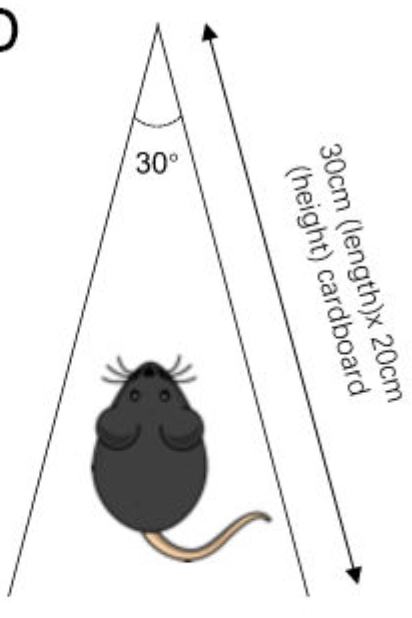
转角实验
Corner Test 转角实验
产品编号:COR302001M(小鼠),COR432001R(大鼠)
The corner test assesses the direction pattern of sensorimotor
dysfunction. It was initially
applied on rats, and later modified to use
on mice. Generally, two 30cm × 20cm cardboards are attached at 30° angle
with a small opening at the joint. Animals are placed in the middle of the two
cardboards, so that vibrissae on both sides can be stimulated when they enter
the corner. The direction in which they turn back is recorded. Normally,
animals do not have preference to either direction. After stroke, which causes
contralateral limb deficits, however, animals tend to use their ipsilateral
limbs to turn back. Higher tendency to one side indicates more severe stroke
outcome.
As a sensorimotor asymmetry assessment, corner test has been applied in unilateral stroke studies to evaluate stroke outcome. Ischemic mice made more ipsilateral turns, while sham controls turned to either side equally after ischemic injury. This behavioral asymmetry was detected from 2-90 days after injury. Similarly, ischemic rats displayed significantly more ipsilateral turns than sham controls after ischemic stroke, and the difference could still be observed 4 weeks after injury. In addition, ischemic rats with bone marrow cell treatment made fewer ipsilateral turns within 28 days after injury, indicating decreased sensorimotor deficits. These results suggest that corner test can be used to assess sensorimotor asymmetry after ischemic stroke and evaluate neuroprotective effects of novel treatments.
The corner test is also effective in assess sensorimotor function
in hemorrhagic stroke. It was reported that ICH rats showed significant
increased ipsilateral turns compared to sham controls, and that this asymmetry
remained detectable 4 weeks after injury. In
addition, ICH rats with deferoxamine treatment made less ipsilateral turns at
day 28 after stroke, indicating improved recovery. These
findings suggest that the corner test is also able to assess sensorimotor
function in ICH. It should be noted that the corner test cannot be used in SAH,
which causes global brain damage and thus minimal sensorimotor asymmetry.
Compared to other tests that assess sensorimotor asymmetry, corner test has several advantages. First, it is an objective and quantitative test. Next, the corner test is able to evaluate sensorimotor deficits in the chronic phase after stroke. One drawback of the corner test, however, is that animals may not perform well when they are too sick or lose motivation due to repeated testing. To reduce or avoid this effect, long intervals should be given between tests. In addition, the use of corner test should be limited to unilateral stroke models, since global stroke models (e.g. global ischemia and SAH) result in mild sensorimotor asymmetry.






